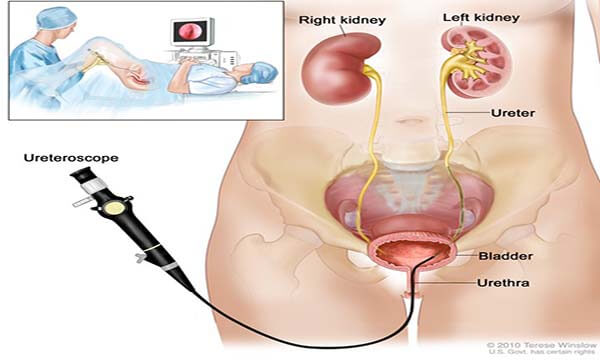News - Sun, 06/18/2017 - 16:59
Ureteroscopy in diagnosis & treatment of ureteral pathology
Last update 09/19/2017 - 11:24
>>> Treatment of kidney stones, ureteral stones by Percutaneous Nephrolithotomy technique
>>> Treatment of ureteral stones by Extracorporeal Shock Wave Lithotripsy using STORZ system

Surgical pathology of the ureter is relatively common, including: ureteral stone, stenosis, tumors… Conventional treatment for this condition is open surgery – a necessary surgery but is always accompanied by disadvantages such as incision of muscle abdomen, severe pain, prolonged hospitalization, high risk of infection, even probably complication of ureteral stenosis.
Current trend in the surgical treatment is to apply high technology, mini-invasive in replacing the more conventional operative procedures. Ureteroscopy helps urologists to overcome the problems mentioned above. It is not only a means of diagnosis but also as a useful treatment, alternative to most indications for open surgery in the treatment of ureter.
What’s ureteroscopy?
Under epidural or general anesthesia, an ureteroscope is passed through the urethra and bladder and into the ureter. This scope contains a camera, which allows viewing a clearly ureter & renal calyx and determining disease. Moreover, with the ureteroscope, the surgeon can place into the ureter the special channels to capture or break up the stone, ureterostomy and biopsies. At the end of the procedure, a special tube (JJ sonde) is inserted in the ureter between the kidney and bladder. This tube is to make sure urine can flow from your kidneys down to the bladder and ureteral obstruction or stenosis is avoided. A JJ sonde is not troubled to patient, and is removed easily by cystoscopy.
There are 3 types of ureteroscopes: rigid, semirigid and flexible. Flexible ureteroscope is for diagnosis; because that it can be used for explore middle and inferior calices. Rigid & semirigid ureteroscopy is mainly used for treatment besides diagnosis.
Application of Ureteroscopy
Treatment for ureteral stone:
The ureter is the tube that carries urine from the kidney to the bladder. Obstructive stone in the ureter will cause the severe pain in the kidney & quickly damage to the kidney if not be treated. Most kidney stones are small and pass out naturally with the urine. Large stones do not always pass on their own and require a surgical treatment to remove them.
ESWL is the first choice of treatment for the kidney and upper ureteral stones but not away efficacious. ESWL may not be effective for treating ureteral stones in the lower pelvic area.
Ureteroscopy is indicated for :
- All types of ureteral stones that is not treatable by ESWL. It may apply for pyelic & upper calice stones.
- Failed previous ESWL treatment attempts.
- Recurrent ureteral stone/ureteral stenosis after open surgery
Depending on the size, stone can be pick-up or break it up into smaller pieces by lithotripsy and may be removed through the ureteroscope. In some cases, the stone may be pushed into the kidney for later treatment by ESWL. It avoids ureteral blockage & moreover, the kidney stone is broken up easier by ESWL than ureteral stone.
Ureteroscopy is an example of application of high technology, mini-invasive and avoid open surgery. It not only allows Urologist to see the stone through the X - ray but also a clear view by camera. It is not merely a means of diagnosis but also an effective treatment.
Soft procedure, mini-invasive, less pain, hospitalization’s time from 24-28h. Patients can return to work after 4-5 days. It helps us to achieve treatment guidelines: “STONE FREE – LESS PAIN – QUICK RECOVERY”.
Depending on the severity of your symptoms, you should immediately see an Urologist or go directly to the emergency room for relief: severe lumbar pain & may spread down into groin, scrotum, hematuria, burning, polakiuria…
Treatment of ureteral stenosis
Ureteral stenosis can be caused by acquired disease: after surgical treatment for ureter, tumors compressed ureter…Congenital disease: Pyelo-ureteral junction syndrome, ureterocele…
The common treatment involves open surgery. Ureteroscopy may allow us to avoid this surgery.
Under general or epidural anesthesia, an ureteroscope is passed into the ureteral stenosis, which Surgeon uses urétérotomie to expand in diameter. Then, special stent is placed into the ureter through ureteroscope, this stent has a ballon in one head to dilate the ureteral stenosis ( ballon de dilatation)
Recently there are special instruments to help simplify the procedure. This is a stent with a balloon at the top, which may be inflated and it’s attached a thin wire to help the ballon-urétérotomie cutting exactly along ureteral stenosis & then dilate the ureter (ballon-urétérotomie).
It’s also can use directly ureteral dilatator to dilate the ureteral stenosis.
At the end of procedure, a JJ sonde inserted to keep the ureteral stenosis in normal size after healing. JJ sonde will be removed easily after 3-4 weeks.
This is a mini-invasive operation and takes only 30 - 60 minutes. Hospitalization’s time is from 24 to 48 hours. No pain effects to patient & no open surgery required.
Ureteroscopy for diagnosis and treatment o uro-epithelial tumors
Diagnosis of a tumor inside the ureter & kidney cavity, especially at the early stage is not always easy by radio-imagery.
It shows simple symptoms such as hematuria, weary back. Sometimes, an UIV even CT scan may not effective. Urinary cytology may give wrong negative result, moreover, benign tumors always give negative results.
In these suspected cases, ureteroscopy is really an effective way which allows the urologist to view lesion & making a biopsy. Furthermore, uretoroscopy can be able to do the tumorectomy, applied for the benign tumors, malign tumor in early-stage, and malign tumors without surgical indication: unique kidney, tumors in bilateral kidneys.
Suggested signs for early consultation: pain in the back, hematuria without causes.
Conclusion: With the advantages of endoscopy in general, ureteroscopy is a typic example with the ability to diagnosis and treatment has changed the basic strategy for surgical treatment of urinary pathologies. Ureteroscopy one such newer technique that helps us to early detect and diagnose some uro-epithelial tumors. The patient can be avoiding of surgery and no pain with short hospitalization.
The patients should immediately see an Urologist or go directly to the emergency room if you have these symptoms: back pain, colic nephritis, hematuria, prolonged urinary infection, past medical history of ureteral operation.
For further information, please contact us at: (84-24) 3577 1100 or send us an inquiry here



